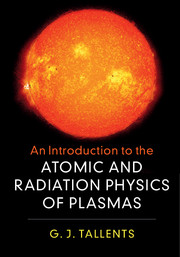Book contents
- Frontmatter
- Contents
- Preface
- 1 Plasma and Atomic Physics
- 2 The Propagation of Light
- 3 Scattering
- 4 Radiation Emission in Plasmas
- 5 Radiation Emission Involving Free Electrons
- 6 Opacity
- 7 Discrete Bound Quantum States: Hydrogen and Hydrogen-Like Ions
- 8 Discrete Bound States: Many-Electron Atoms and Ions
- 9 Discrete Bound States: Molecules
- 10 Radiative Transitions between Discrete Quantum States
- 11 Collisions
- 12 Collisional-Radiative Models
- 13 High-Density Plasmas
- Appendix Vectors, Maxwell's Equations, the Harmonic Oscillator and a Sum Rule
- References
- Index
3 - Scattering
Published online by Cambridge University Press: 21 February 2018
- Frontmatter
- Contents
- Preface
- 1 Plasma and Atomic Physics
- 2 The Propagation of Light
- 3 Scattering
- 4 Radiation Emission in Plasmas
- 5 Radiation Emission Involving Free Electrons
- 6 Opacity
- 7 Discrete Bound Quantum States: Hydrogen and Hydrogen-Like Ions
- 8 Discrete Bound States: Many-Electron Atoms and Ions
- 9 Discrete Bound States: Molecules
- 10 Radiative Transitions between Discrete Quantum States
- 11 Collisions
- 12 Collisional-Radiative Models
- 13 High-Density Plasmas
- Appendix Vectors, Maxwell's Equations, the Harmonic Oscillator and a Sum Rule
- References
- Index
Summary
Free and bound electrons in a plasma are accelerated by electromagnetic radiation. The interaction with the electrons affects the propagation of the radiation by altering the phase of the oscillating electric and magnetic field of the electromagnetic wave and by absorption of the electromagnetic wave energy as discussed in Chapter 2. As well as affecting a propagating electromagnetic wave, the acceleration of the free and bound electrons in a medium also gives rise to radiation emission: a process referred to as ‘scattering’.
As the acceleration of electrons affects the propagation of electromagnetic waves while producing emission of radiation, scattering of light by electrons in a medium can be regarded as determining the optical properties of the medium. Resonances in the responses of free and bound electrons to oscillations from electromagnetic waves tend to have a dominant effect on light propagation. We determined the refractive index arising in plasmas from free electrons and the resonance at the plasma frequency (see Section 2.1). Other resonances associated, for example, with bound electrons also produce refractive index effects.
By determining the refractive index of the medium in which light propagates, scattering processes ultimately govern the reflection and refraction behaviour of light at the junction between materials with different refractive indices. For example, macroscopic particles such as dust in plasmas or water droplets in clouds in the atmosphere reflect light from surfaces (known as Mie scattering). Gradients of refractive index lead to refractive bending of the direction of light propagation.
The fraction of electromagnetic radiation scattered by free electrons is typically a small loss mechanism for radiation of frequency much greater than the plasma frequency, but it is useful for diagnosing conditions in plasmas. For diagnostic measurements of plasmas at optical (ultra-violet to infra-red) frequencies, a laser radiation source is usually employed so that light can be spatially located and the high laser power per unit area ensures that the scattered light is greater than the emission associated with the thermal energy of the plasma. With radio waves and ionospheric scattering, high-power radar systems are employed. In dense plasmas of relevance to inertial fusion, incoherent X-ray sources or free-electron laser sources are used [99].
Information
- Type
- Chapter
- Information
- Publisher: Cambridge University PressPrint publication year: 2018
